All the solutions provided in McGraw Hill My Math Grade 3 Answer Key PDF Chapter 9 Lesson 2 Two Distributive Property will give you a clear idea of the concepts.
McGraw-Hill My Math Grade 3 Answer Key Chapter 9 Lesson 2 Two Distributive Property
The Distributive Property allows you to decompose one factor. Then you can use smaller known facts to find products.
Math in My World
Example 1
Henry’s Hardware Store sells wrench sets. Each set holds 6 wrenches. How many wrenches are there in 8 sets?

Find 8 × 6.
Decompose one factor.
One way is to decompose 6 into 5 + 1.
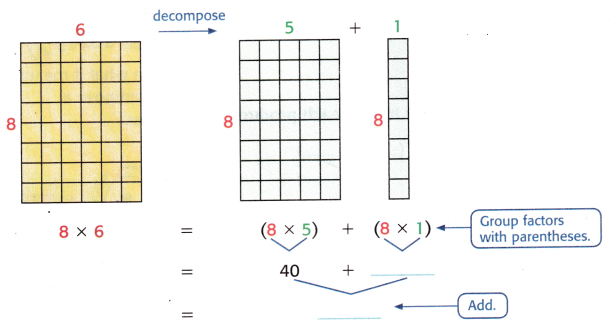
So, 8 × 6 = ____________. There are ___________ wrenches.
Answer: 8 × 6 = 48 , There are 48 wrenches

Explanation:
Given, 8 × 6
decompose the factor 6 into 5 + 1.
8 × 6 = ( 8 × 5 ) + ( 8 × 1 )
48 = 40 + 8
48 = 48
8 × 6 = 48
So, There are 48 wrenches
Example 2
Karma’s dad used 7 boards to build a picnic table. How many nails were used if each board needed 7 nails?
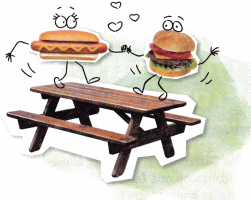
Find 7 × 7.
Decompose one factor.
One way is to decompose 7 into 5 + 2.

So, Karma and her dad used _____________ nails altogether.
Answer: Karma and her dad used 49 nails altogether.
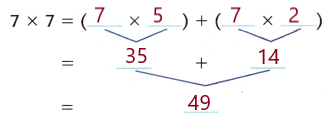
Explanation:
Given, 7 × 7
decompose the factor 7 into 5 + 2.
7 × 7 = ( 7 × 5 ) + ( 7 × 2 )
49 = 35 + 14
49 = 49
7 × 7 = 49
So, Karma and her dad used 49 nails altogether.
Talk Math
Explain what it means to decompose a number.
Answer: To decompose in math is to break down numbers into parts. Add: To add is to join two numbers together. Subtract: To subtract is to take away from another to see the difference. Place Value: Place value is the value represented by a digit in a number on the basis of its position in the number.
Guided Practice
Use the Distributive Property to find each product.
Question 1.
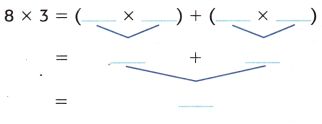
Answer: 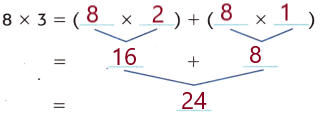
Explanation:
Given, 8 × 3
By using Distributive Property we get.
8 × 3 = ( 8 × 2 ) + ( 8 × 1 )
= 16 + 8
= 24
So, 8 × 3 = 24.
Question 2.
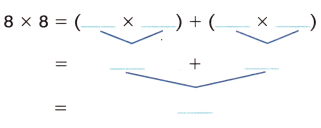
Answer: 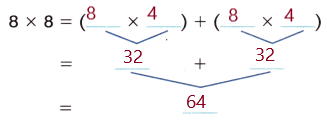
Explanation:
Given, 8 × 8
By using Distributive Property we get.
8 × 8 = ( 8 × 4 ) + ( 8 × 4 )
= 32 + 32
= 64
So, 8 × 8 = 64.
Independent Practice
Use the Distributive Property to find each product.
Question 3.
4 × 6 = ____________
Answer: 4 × 6 = 24
Explanation:
Given, 4 × 6
By using Distributive Property we get.
4 × 6 = ( 4 × 3 ) + ( 4 × 3 )
= 12 + 12
= 24
So, 4 × 6 = 24.
Question 4.
6 × 6 = ______________
Answer: 6 × 6 = 36
Explanation:
Given, 6 × 6
By using Distributive Property we get.
6 × 6 = ( 6 × 3 ) + ( 6 × 3 )
= 18 + 18
= 36
So, 6 × 6 = 36.
Question 5.
8 × 9 = _____________
Answer: 8 × 9 = 72
Explanation:
Given, 8 × 9
By using Distributive Property we get.
8 × 9 = ( 8 × 5 ) + ( 8 × 4 )
= 40 + 32
= 72
So, 8 × 9 = 72.
Question 6.
10 × 4 = ______________
Answer: 10 × 4 = 40
Explanation:
Given, 10 × 4
By using Distributive Property we get.
10 × 4 = ( 4 × 5 ) + ( 4 × 5 )
= 20 + 20
= 40
So, 10 × 4 = 40.
Question 7.
12 × 4 = _______________
Answer: 12 × 4 = 48
Explanation:
Given, 12 × 4
By using Distributive Property we get.
12 × 4 = ( 6 × 4 ) + ( 6 × 4 )
= 24 + 24
= 48
So, 12 × 4 = 48.
Question 8.
11 × 8 = ________________
Answer: 11 × 8 = 88
Explanation:
Given, 11 × 8
By using Distributive Property we get.
11 × 8 = ( 11 × 4 ) + ( 11 × 4 )
= 44 + 44
= 88
So, 11 × 8 = 88.
Question 9.
10 × 10 = _______________
Answer: 10 × 10 = 100
Explanation:
Given, 10 × 10
By using Distributive Property we get.
10 × 10 = ( 10 × 5 ) + ( 10 × 5 )
= 50 + 50
= 100
So, 10 × 10 = 100.
Question 10.
12 × 6 = ________________
Answer: 12 × 6 = 72
Explanation:
Given, 8 × 8
By using Distributive Property we get.
12 × 6 = ( 12 × 3 ) + ( 12 × 3 )
= 36 + 36
= 72
So, 12 × 6 = 72.
Problem Solving
Question 11.
Mathematical PRACTICE Identify Structure The Fix It Right Hardware Store is open 12 hours every day. How many hours are they open altogether from Monday through Friday?
Answer: They are open 60 hours altogether from Monday through Friday.
Explanation:
Given, The Fix It Right Hardware Store is open 12 hours every day.
How many hours are they open altogether from Monday through Friday
12 hours for 5 days
Then, 12 × 5
decompose the factor 6 into 5 + 1.
12 × 5 = ( 6 × 5 ) + ( 6 × 5 )
= 30 + 30
= 60
12 × 5 = 60
So, They are open 60 hours altogether from Monday through Friday.
Question 12.
A restaurant orders 9 dozen eggs. The picture shows the number of eggs from each dozen that broke during shipping. How many eggs are unbroken? (Hint: 1 dozen = 12)
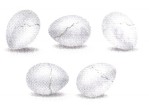
Answer: 103 eggs are unbroken
Explanation:
Given, A restaurant orders 9 dozen eggs.
1 dozen = 12
Then, 12 × 9 = ( 6 × 9 ) + ( 6 × 9 )
= 54 + 54
= 108
12 × 9 = 108
totally 108 eggs are there
Among them 5 eggs are broken
108 – 5 = 103
So, 103 eggs are unbroken
Question 13.
Each aquarium has 10 clown fish and 6 puffer fish. There are 7 aquariums. How many fish are there in all?
Answer: There are 112 fish in all the aquarium
Explanation:
Given, Each aquarium has 10 clown fish and 6 puffer fish.
That means, 10 + 6 = 16 fish in an Aquarium
There are 7 Aquariums
16 × 7 = ( 7 × 10 ) + ( 7 + 6 )
= 70 + 42
= 112
So, There are 112 fish in all the aquarium.
HOT Problems
Question 14.
Mathematical PRACTICE Make Sense of Problems There are 12 inches in one foot and 3 feet in one yard. How many inches are in 2 yards?
Answer: There are 72 inches in 2 yards
Explanation:
Given, There are 12 inches in one foot and 3 feet in one yard.
That means, 12 × 3 = 36
Then for 2 yards ,it will be
36 + 36 = 72
So, There are 72 inches in 2 yards.
Question 15.
Building on the Essential Question How are parentheses used when grouping factors?
Answer: Parentheses are for the innermost group. If a second grouping , which will include the part already in parentheses, is needed, square brackets are used. If a third grouping, which will include a section with parentheses and square brackets, is necessary, then braces are used.
McGraw Hill My Math Grade 3 Chapter 9 Lesson 2 My Homework Answer Key
Practice
Use the Distributive Property to find each product.
Question 1.
4 × 9 = ______________
Answer: 4 × 9 = 36
Given, 4 × 9
By using Distributive Property we get.
4 × 9 = ( 4 × 5 ) + ( 4 × 4 )
= 20 + 16
= 36
So, 4 × 9 = 36.
Question 2.
5 × 6 = ______________
Answer: 5 × 6 = 30
Given, 5 × 6
By using Distributive Property we get.
5 × 6 = ( 5 × 3 ) + ( 5 × 3 )
= 15 + 15
= 30
So, 5 × 6 = 30.
Question 3.
5 × 11 = _______________
Answer: 5 × 11 = 55
Given, 5 × 11
By using Distributive Property we get.
5 × 11 = ( 5 × 6 ) + ( 5 × 5 )
= 30 + 25
= 55
So, 5 × 11 = 55.
Question 4.
12 × 7 = ______________
Answer: 12 × 7 = 84
Given, 12 × 7
By using Distributive Property we get.
12 × 7 = ( 6 × 7 ) + ( 6 × 7 )
= 42 + 42
= 84
So, 12 × 7 = 84.
Problem Solving
Question 5.
Milly bought 4 bags of apples at the grocery store. Each bag contains 6 apples. How many apples does Milly have in all?
Answer: Milly has 24 apples in all
Explanation:
Given, Milly bought 4 bags of apples at the grocery store.
Each bag contains 6 apples.
6 × 4 = 24
So, Milly has 24 apples in all
Question 6.
Mathematical PRACTICE Identify Structure Byron scrambled 8 dozen eggs for the campers. What is the total number of eggs Byron scrambled? (Hint: 1 dozen = 12)
Answer: Byron has scrambled 96 eggs
Explanation:
Given, Byron scrambled 8 dozen eggs for the campers.
1 dozen = 12 eggs
Then, 8 dozen eggs are ,
12 × 8 = 96
So, Byron has scrambled 96 eggs.
Question 7.
There are 6 seats in each row in the theater. If 8 rows are filled with people, how many people are in the theater?
Answer: 48 people are there in the theater
Explanation:
Given, There are 6 seats in each row in the theater,
If 8 rows are filled with people,
6 × 8 = 48
So, 48 people are there in the theater.
Vocabulary Check
Question 8.
Explain how you could use the Distributive Property to decompose a factor and find the product of 5 × 9.
Answer: 5 × 9 = 45
Explanation:
Given, 5 × 9
By using Distributive Property to decompose a factor 9 in to 6 + 3 ,
we get.
5 × 9 = ( 5 × 6 ) + ( 5 × 3 )
= 30 + 15
= 45
So, 5 × 9 = 45.
Test Practice
Question 9.
Which shows the correct use of the Distributive Property to find 4×12?
(A) (2 × 6) + (2 × 6)
(B) (4 × 10) + (4 × 2)
(C) (4 × 6) + (2 × 6)
(D) (4 × 8) + (4 × 3)
Answer: B
Explanation:
Given, 4 × 12
By using Distributive Property we get.
4 × 12 = ( 4 × 10 ) + ( 4 × 2 )
= 40 + 8
= 48
4 × 12 = 48.
So, (4 × 10) + (4 × 2) is the correct option.